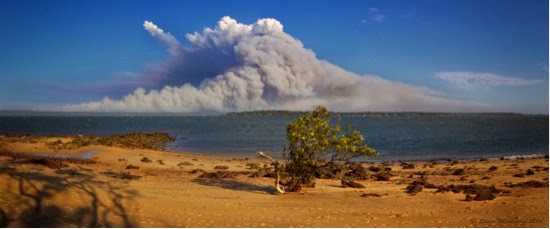The Spirited Wagtail
One of Straddie’s most delightful common birds, the Willie
Wagtail was recently the subject of a blog by Queensland wildlife writer Robert
Ashdown. Robert gave permission to FOSI to reproduce his musings…
Found almost
everywhere
Small but fierce,
with serious eyebrows
A spirited and
sweet voice
Eats almost anything
Determined parents
The last word
“I don’t usually
associate Willie Wagtails (Rhipidura leucophrys) with beaches, but some
beautiful images taken at North Stradbroke Island by Michael Hines made me
ponder just how ubiquitous these real characters are.
 |
| A jaunty-looking Willy Wagtail ponders the surf, North Stradbroke Island. |
The Willie Wagtail is
one of Australia’s most familiar birds, found throughout most of the continent.
The name “wagtail” is confusing, because although it flicks and wags its tail
from side to side, it is actually a member of the fantail family, and not one
of the wagtails of Europe and Asia. [Bird: The DK Definitive Visual Guide]
Found almost
everywhere
Exploring clearings,
and familiar in urban areas, Willie Wagtails forage conspicuously in open
places and are the only fantails to feed constantly from the ground. Through
this capacity they have spread throughout Australia, avoiding only dense
forests and treeless, perchless plains. [Reader's Digest Complete Book of
Australian Birds.]
Small but fierce,
with serious eyebrows
When breeding, Willy
Wagtails defend their territory against even large predators, circling their
attacker’s head in a figure-of-eight pattern uttering an aggressive
‘ricka-ticka-ticka-tick’. They defend their territory against other wagtails,
enlarging their eyebrows in threat. Defeat is signalled by reducing the
eyebrows and retreating. [Reader's Digest Encylopedia of Australian Wildlife.]
A spirited and
sweet voice
As a child I remember
lying in bed at night listening to a strange bird call that would echo off the
quiet houses —”sweet pretty creature” — loud and repeated for what seemed
forever. Adults had no answers to my questions about this call, and it took me
many years to work out that it was a Willie Wagtail. The nocturnal call of the
Willie Wagtail is most commonly heard during moonlit nights and especially
during the breeding season (August to February). From my own experience, the presence
of a bright street light or car park lighting can also contribute to this
phenomenon.
Once started, the song
can continue for lengthy periods, often stimulating other birds nearby to also
call. It is thought that the nocturnal song in Willie Wagtails is used to
maintain its territory. During the night there is no need for parental duties
such as feeding the young or protecting the nest, so the song can be used to
consolidate the territory. Sound tends to carry further at night and there are
fewer sounds in competition and this adds to its effectiveness. It has been
found that most nocturnal songs are from a roosting bird some distance away
from the nest.
Eats almost anything
The Willie Wagtail is
an adaptable bird with an opportunistic diet. It flies from perches to catch
insects on the wing, but will also chase prey on the ground. Wagtails eat,
among other things, butterflies, beetles, flies, dragonflies, spiders and
millipedes.
They will often hop
along the ground behind people and animals as they walk over grassed areas, to
catch any creatures that they flush out. These birds wag their tails in a
horizontal fashion while foraging. Why they do this is unknown but it may help
to flush out hidden insects — or maybe they just like wagging their tails.
Determined parents
Willie Wagtails
usually pair for life. Anywhere up to four broods may be raised during the
breeding season, which lasts from July to December, more often occurring after
rain in drier regions.
Willie Wagtails build
a cup-like nest, made of strips of bark or grass stems, and woven together with
spider web or even hair from dogs or cats. They have even been seen trying to
get hair from a pet goat. Photo courtesy Mike Peisley.
Wagtails may build
nests on or near buildings, and sometimes near the nest of Magpie-larks,
perhaps taking advantage of the aggressive and territorial nature of the latter
bird, as it will attempt to drive off intruders.
From two to four small
cream-white eggs with brownish markings are laid, and these are incubated for
about 14 days. Both parents take part in feeding the young, and may continue to
do so while embarking on another brood. Nestlings remain in the nest for around
14 days before fledging. Upon leaving, the fledglings will remain hidden in
cover nearby for one or two days before venturing further afield. Parents will
stop feeding their fledglings near the end of the second week, as the young
birds increasingly forage for themselves, and soon afterwards drive them out of
the territory. [Wikipedia]
The last word
Widespread,
well-loved. [Graham Pizzey. The Graham Pizzey and Frank Knight Field Guide to
the Birds of Australia.]
Thanks again to Robert
Ashdown for allowing FOSI to publish this edited (for space) version of his
June 2012 blog – to read the whole blog including an interesting discussion of
Aboriginal names and stories and view more beautiful photos go to http://www.robertashdown.com/blog/
^




